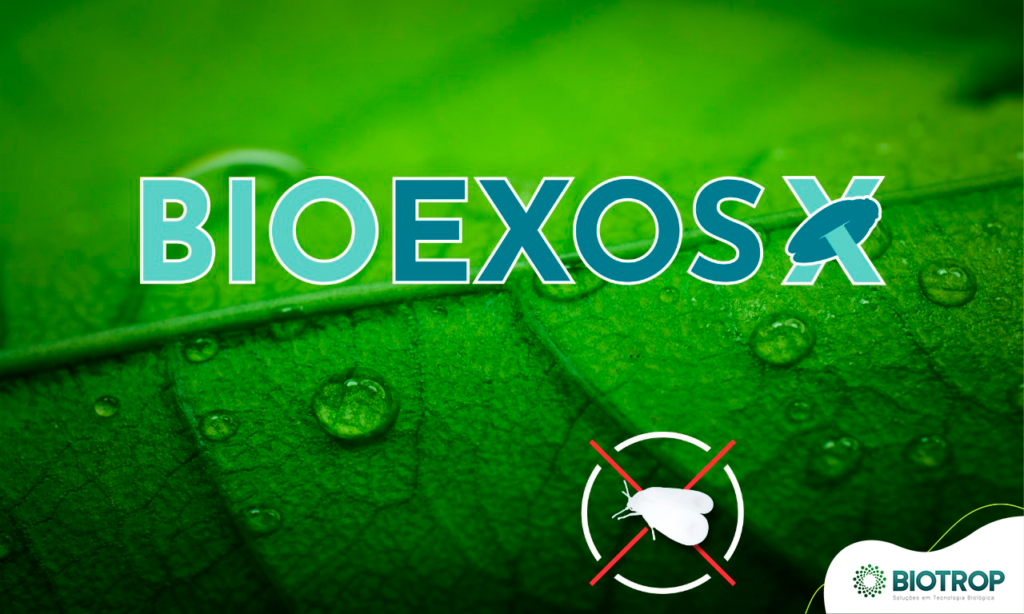Whitefly management: get to know Bioexos’ highlights
Whitefly: Learn more about the new bioinsecticide Bioexos, its mode of action, application, and more!
One of Brazil’s major agricultural problems has been managing insecticide-resistant pests
With that in mind, aiming to improve integrated pest management (IPM) practices even more, the bioinsecticide Bioexos, which is registered for a number of crops, was launched onto the market.
If you would like to learn more about the importance of launching this product as well as its importance for the Brazilian market, check it out!
Whitefly management
The presence of whitefly (Bemisia argentifolii and Bemisia tabaci) in the fields has become more and more common and this pest is related to losses in productivity.
Whiteflies have a short life cycle, which ranges from 6 to 25 days, disperse easily, are polyphagous (they feed on different plant species), and have high reproduction rates (females lay, on average, 100 to 300 eggs), which results in high infestation levels.
In addition, the selection of resistant populations occurs on a regular basis.
Therefore, the adoption of integrated pest management practices is crucial in order to avoid further losses on your property and avoid future issues, such as resistance.
With that in mind, Bioexos is the solution for whitefly management.

Whitefly
(Source: Agrolink)
Bioexos has recently been registered with MAPA (Ministry of Agriculture, Livestock and Food Supply).
How does the bioinsecticide Bioexos work?
The product has the active ingredient azadirachtin, which is extracted from the seeds of a tree from southeastern Asia and from the Indian subcontinent (Azadirachta indica), in its formulation.
This is one of the latest and most efficient neem oil formulations.
It does not cause harm or adverse effects to the environment.
In addition to its repellent effect, the product regulates the growth of insects, and causes interruption of their feeding process and life cycle.
Bioexos can be applied to all crops under the attack of the biological target.
It is an excellent alternative to minimize costs with insecticides and avoid resistance via natural selection.
Thus, in case you have issues related to resistance to chemical insecticides by Bemisia argentifolii, Bemisia tabaci and Erysiphe polygoni, using Bioexos can be a great strategy when it comes to integrated management practices.
Despite being a biobased insecticide, be careful with the indiscriminate use of Bioexos. This product should be an additional tool for integrated pest management practices and the recommendations on its label must be followed.
Bioexos’ mode of action
Azadirachtin acts on the behavior and physiology of pests, including their growth, reproduction, feeding, and mortality.
In practice, Bioexos, as a result of its mode of action, affects the development of insects and decreases the appearance of high populations of the pest.
Another differentiating factor of the product consists in a rapid elimination of the substance from the organism of insects (around 24 hours, which is long enough to compromise their development).
Thus, avoiding the exposure of predators to the same doses to which preys were subjected.

Product efficiency
The use of bioinsecticides can be an excellent choice when it comes to integrated pest management practices.
Studies carried out at the Federal University of Ceará showed the efficiency of the application of a formulation based on Azadirachtin to control whitefly in melon, which indicated that the application of the product could lead to reduction of nymphs of up to 98%.
Researchers from the State University of Mato Grosso do Sul found similar results for tomatoes, in which the application of Azadirachtin reduced the number of whitefly eggs significantly.
Bioexos application
For higher efficiency of the product, some precautions (i.e., application timing) are crucial.
For beans, for example, in cases of infestation by Erysiphe polygoni, apply the product after the appearance of first symptoms.
If your tomato or bean crop is infested by whiteflies, apply the product at the beginning of the infestation.
It is crucial that you monitor your crops constantly.
This is the decisive point for knowing when it is necessary to use control strategies and avoid possible economic losses.
You can apply Bioexos in two different ways: ground and aerial application.
After choosing an application method, follow the recommendations for application and preparation of the solution on the product’s label.
Bioinsecticide benefits
By choosing Bioexos, you will bring more safety to your property.
The product has very low toxicity levels, ensuring more safety to applicators.
In addition to low environmental hazard, that is, it does not harm the environment.
Bioexos also has the characteristics below:
- Does not leave residues in the field;
- Creates selectivity to natural enemies in the field;
- There is no re-entry interval;
- Can be associated with chemical products;
- Highly efficient active ingredient;
- Stable formulation (avoiding, for example, solidification, which is often observed in similar products).
The product is a solution for both conventional and organic farming, bringing benefits to different types of growers and production systems.
Conclusion
Considering all the effort you put into your crops, you cannot lose productivity because of pests. Bioexos can be a great alternative regarding integrated pest management practices.
In this article, we discussed the most important differentiating factors of this product as well as how it works on pests. We hope that the information above helps you manage whiteflies effectively on your property!
Do you have problems with whiteflies on your farm? What control strategies do you use? Have you heard of Bioexos? We would like to see your comment below!

